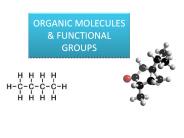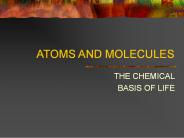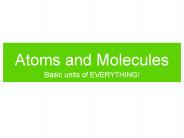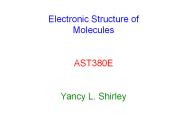Molecules PowerPoint PPT Presentations
All Time
Recommended
What molecules cross the cell membrane? How do these molecules cross the cell membrane? ... Diffusion rate depends on the surface area of the cell mb. ...
| PowerPoint PPT presentation | free to download
Chemical reactions involve the rearrangement of the atoms within and between molecules that results in the formation of new molecules. This process involves the ...
| PowerPoint PPT presentation | free to download
The container on the left is cooler, the molecules move slower (have less kinetic energy) and exert a smaller pressure on the container walls compared to the ...
| PowerPoint PPT presentation | free to download
... [aka macro-molecule] Organelle Cell Tissue Organ ... straw in water water climbs above the surface level aka capillary action major way blood flows through ...
| PowerPoint PPT presentation | free to view
organic molecules & functional groups
| PowerPoint PPT presentation | free to download
Biological Molecules Biology Mr. Evans
| PowerPoint PPT presentation | free to download
Naming Molecules Naming Acids Acid rule 1: binary acids (HX) hydro_____ic acid Fill in the blank with the root of the element HCl hydrochloric acid Naming Acids Acid ...
| PowerPoint PPT presentation | free to download
biological molecules electron -- charge orbit around nucleus same # as protons proton + charge found in nucleus same # as electrons neutron 0 charge found in ...
| PowerPoint PPT presentation | free to download
Title: Biological Molecules Author: Joe Last modified by: Rutherford Created Date: 2/13/2003 5:05:55 AM Document presentation format: On-screen Show (4:3)
| PowerPoint PPT presentation | free to download
Biological Molecules. Carbon based molecules (Organic) ... Biological Molecules 'Pimp my ride Biology' ... Act as biological catalysts. Increase the rate of ...
| PowerPoint PPT presentation | free to view
Diatomic molecules The observation that the molar heat capacity of nitrogen and oxygen is about 5R/2 enabled Clausius to speculate (in about 1880) that these gases ...
| PowerPoint PPT presentation | free to download
Organic Molecules Chapter 20 Organic Chemistry Two essential elements are located in column 14 of the periodic table: Carbon Silicon Silicon bonds with four single ...
| PowerPoint PPT presentation | free to download
Secondary simple cross-links or folds ... Times New Roman Default Design nutrient molecules Slide 2 the solo arctic adventurer s debate Slide 4 Slide ...
| PowerPoint PPT presentation | free to download
Organic molecules
| PowerPoint PPT presentation | free to view
Molecules of Life
| PowerPoint PPT presentation | free to view
Molecules of Life Chapter 3
| PowerPoint PPT presentation | free to view
Atomic Binding - Molecular Bonds Atoms are known to come together to form molecules which can be relatively simple (e.g. the hydrogen molecule H2) or very complex (e ...
| PowerPoint PPT presentation | free to download
CD molecules & Disease ...
| PowerPoint PPT presentation | free to view
Chemical Bonds Continued Unit 4 - MoLECULES
| PowerPoint PPT presentation | free to download
atoms and molecules the chemical basis of life
| PowerPoint PPT presentation | free to download
Molecules of Life
| PowerPoint PPT presentation | free to view
Title: Atoms and Molecules Last modified by: Western Oregon University Document presentation format: Custom Other titles: Futura ProN W3 Arial ...
| PowerPoint PPT presentation | free to download
Atoms are made of molecules. Molecules are made of atoms. What is the smallest structure in this list that can be seen with an ordinary desk microscope? Cells.
| PowerPoint PPT presentation | free to view
Atoms and Molecules Basic units of EVERYTHING! Atoms In our model of scale, remember that the BB represented an atom. As a class, identify the atoms represented here ...
| PowerPoint PPT presentation | free to download
Structure to Function. Molecules of life differ in three-dimensional structure and function. Carbon backbone. carbon and hydrogen atoms. bond covalently with up to ...
| PowerPoint PPT presentation | free to view
Molecules of Life Carbohydrates -Organic compounds -Composed of carbon, hydrogen, and oxygen -Three types: monosaccharide, disaccharide, and polysaccharide 1.
| PowerPoint PPT presentation | free to view
Certain molecules dissociate into ions when they are placed in water. Acids. Bases. ACID: Substance that dissociates in water and INCREASES the H ion concentration ...
| PowerPoint PPT presentation | free to view
Relatively large combinations of atoms of these elements ... Octane. Methane Molecule. Carbon bonds. Carbon-Carbon bonds release a lot of energy when broken ...
| PowerPoint PPT presentation | free to view
Organic Molecules Molecules of Life Molecules of our Food Organic (Food) Molecules Found in and produced by living organisms Large and complex Carbon to carbon ...
| PowerPoint PPT presentation | free to view
Module 1 Biological Molecules F212 Molecules, biodiversity, food and health
| PowerPoint PPT presentation | free to view
Atoms and Molecules Atom is smallest particle that can be identified as a particular substance. Molecule is two or more atoms bonded to each other.
| PowerPoint PPT presentation | free to download
Chapter 10 The Shapes of Molecules
| PowerPoint PPT presentation | free to view
Atoms, Molecules, and Ions
| PowerPoint PPT presentation | free to view
the molecules of life chapter 3
| PowerPoint PPT presentation | free to download
Cells are mostly water and carbon-based molecules ... Sugars a Major Cause of a Tooth Decay. Feed bacteria. Polysaccharides. Poly' = many ...
| PowerPoint PPT presentation | free to view
Molecules and Compounds Chapter Three Molecules Molecules are groups of atoms chemically bonded together. Molecules may be elements (the diatomic, sulfur and ...
| PowerPoint PPT presentation | free to view
Four or Five carbon rings. bonded together. Steroids are not true lipid molecules ... H OH. OH H. DEHYDRATION SYNTHESIS. Amino acids bond together to form large ...
| PowerPoint PPT presentation | free to view
polar bonds and molecules notes 16.3
| PowerPoint PPT presentation | free to download
Title: THE MOLECULES OF LIFE Last modified by: Modupe Created Date: 8/16/2006 12:00:00 AM Document presentation format: On-screen Show (4:3) Other titles
| PowerPoint PPT presentation | free to view
Chapter Two Atoms, Molecules, and Ions Laws of Chemical Combination Law of Conservation of Mass The total mass remains constant during a chemical reaction.
| PowerPoint PPT presentation | free to download
Atoms, Ions, and Molecules * Bell Ringer 09.07.11 Which of the following represents an organic molecule? A. CuSO4 H2O B. C12H22O11 C. AgNO3 D. H2O Atom Smallest basic ...
| PowerPoint PPT presentation | free to download
Molecules of Life Chapter 2 Part 1 2.1 Impacts/Issues Fear of Frying All living things consist of the same kinds of molecules, but small differences in the ways they ...
| PowerPoint PPT presentation | free to download
Chapter 3 Molecules and Bonds Objectives Ionic Bonding Describe the characteristics of an ionic bond Understand and explain the octet rule Covalent Bonding Describe ...
| PowerPoint PPT presentation | free to download
Atoms, Molecules, and Ions Computer simulation of the interior view of a twisted nanotube. Priestley Medal Figure 2.2: John Dalton Figure 2.3 (P19): Combining gases ...
| PowerPoint PPT presentation | free to download
Carbon Dioxide. Molecules. Carbon dioxide. molecule. Sucrose Molecule. Table sugar. Water Molecule. Sodium Chloride molecule. Table salt ...
| PowerPoint PPT presentation | free to download
HCN BIMA Image. C4H BIMA Image. Why do molecules form? Classical Argument ... Electronic orbital angular momenta precess about internuclear axis due to strong ...
| PowerPoint PPT presentation | free to download
I. Diatomic Molecules. 1. ... I. Diatomic Molecules. 2. Symmetry and designation of electronic states of ... I. Diatomic Molecules. 3. Born-Oppenheimer ...
| PowerPoint PPT presentation | free to view
Molecules of Life Molecules of Life Molecules of life are synthesized by living cells Carbohydrates Lipids Proteins Nucleic acids Organic Compounds Consist ...
| PowerPoint PPT presentation | free to view
The geometry of the molecule at any given central atom is determined by the ... Trigonal bipyramidal. 90o and 120o. sp3d hybrid. sp3d and sp3d2. Hybrid Orbitals ...
| PowerPoint PPT presentation | free to view
Chapter 5 Stereochemistry: Chiral Molecules
| PowerPoint PPT presentation | free to view
For diatomic molecules, the potential curves depend only on R. The ... (Prolate spheroidal coordinates) e. 2dhf is a code to calculate Hartree-Fock energy of ...
| PowerPoint PPT presentation | free to view
Shapes of Molecules Determined by number of valence electrons of the central atom 3-D shape a result of bonded pairs and lone pairs of electrons
| PowerPoint PPT presentation | free to download
"11 minutes ago - COPY LINK TO DOWNLOAD : flip.ebookmarket.pro/pwsep24/B0000547GZ | Download Book [PDF] Molecules of Emotion: Why You Feel the Way You Feel | Molecules of Emotion: Why You Feel the Way You Feel "
| PowerPoint PPT presentation | free to download
Chapter 5 Molecules and Compounds
| PowerPoint PPT presentation | free to view
Polar Bonds and Molecules Bond Polarity The bonding pairs of electrons in covalent bonds are pulled between the nuclei of the atoms sharing the electrons.
| PowerPoint PPT presentation | free to download
The elementary angular momenta of a diatomic molecule. Elementary angular momenta: ... good quantum number for diatomic molecules. Symmetrical top. AMO2: ...
| PowerPoint PPT presentation | free to view
























































